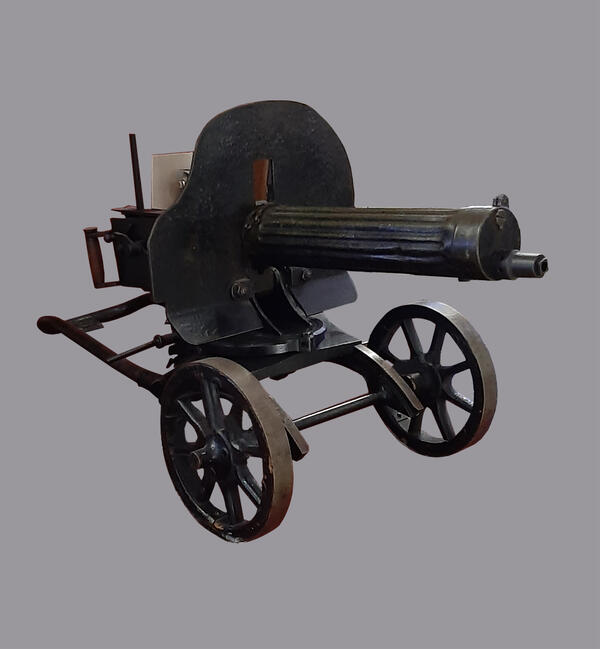The heavy machine gun was developed by the British American gunsmith Hiram Stevens Maxim in 1883. It was used in World War I, Civil War, World War II, and many other military conflicts of the 20th century. In Russia, the Maxim machine gun began to be produced at the Tula Arms Plant in 1904.
The weapon had a high accuracy of shooting and could fire continuously for a long time. The moving parts of the automatic weapon were a barrel with an extension, a breechblock, and levers. The right end of the rear lever axle had a swinging shaped crank, and the left end had an eccentric (rotating disc) with a chain. The chain was connected with a back-moving spring located in a separate housing on the left side of the breech casing. The rotation of the crank set the position of the barrel and breech block.
The shooting was done with the breechblock closed by pushing the firing lever between the cranks. The recoil transmitted to the barrel extension through the breechblock and levers in the dead center, and all moving parts moved backward. After the bullet flew out, the gases entered the muzzle attachment (part of the barrel) and pressed the front end of the barrel, giving the moving parts an added momentum. After the shot, the used cartridge case was automatically ejected from the cartridge chamber and fed into a cartridge-case ejection tube, and the next cartridge was also automatically ejected from the chamber.
Since 1910, the modernized Maxim gun was produced at the Tula Arms Plant under the supervision of I. Pastukhov, I. Sudakov, and P. Tretyakov. The engineers worked on the design of its moving parts and configuration of some details and developed a muzzle brake, which eliminated delays when firing at an angle.
Some of the parts that were made of bronze, for example, cranks, feed-block, and a casing were replaced with the steel ones. Moreover, the engineers improved the sight, trigger bar, and breech casing details. In total, more than 200 changes were made to the weapon. It made the gun 5 kilograms lighter and made the automatic system more reliable.
The weapon had a high accuracy of shooting and could fire continuously for a long time. The moving parts of the automatic weapon were a barrel with an extension, a breechblock, and levers. The right end of the rear lever axle had a swinging shaped crank, and the left end had an eccentric (rotating disc) with a chain. The chain was connected with a back-moving spring located in a separate housing on the left side of the breech casing. The rotation of the crank set the position of the barrel and breech block.
The shooting was done with the breechblock closed by pushing the firing lever between the cranks. The recoil transmitted to the barrel extension through the breechblock and levers in the dead center, and all moving parts moved backward. After the bullet flew out, the gases entered the muzzle attachment (part of the barrel) and pressed the front end of the barrel, giving the moving parts an added momentum. After the shot, the used cartridge case was automatically ejected from the cartridge chamber and fed into a cartridge-case ejection tube, and the next cartridge was also automatically ejected from the chamber.
Since 1910, the modernized Maxim gun was produced at the Tula Arms Plant under the supervision of I. Pastukhov, I. Sudakov, and P. Tretyakov. The engineers worked on the design of its moving parts and configuration of some details and developed a muzzle brake, which eliminated delays when firing at an angle.
Some of the parts that were made of bronze, for example, cranks, feed-block, and a casing were replaced with the steel ones. Moreover, the engineers improved the sight, trigger bar, and breech casing details. In total, more than 200 changes were made to the weapon. It made the gun 5 kilograms lighter and made the automatic system more reliable.



